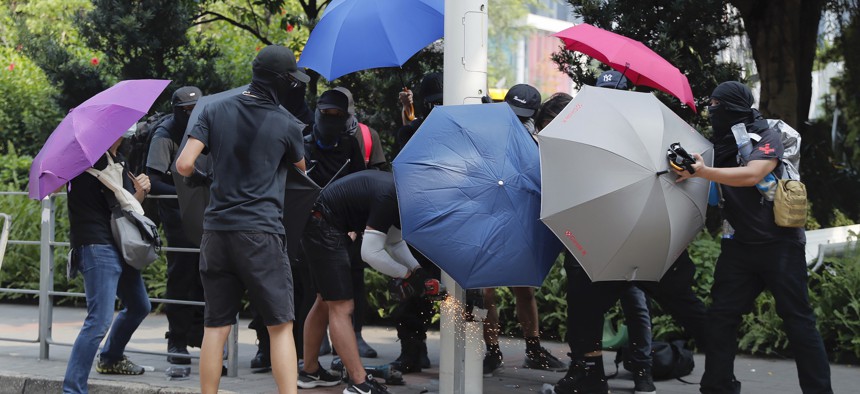
Demonstrators use umbrellas to shield themselves from view while they try to cut down a smart lamppost during a protest in Hong Kong, Saturday, Aug. 24, 2019. AP Photo/Kin Cheung
Why Hong Kong Protesters Are Sawing Down Sensor-Laden Lampposts
The government confirms that the hardware could spy on citizens, but says protesters’ fears are unfounded.
The most successful surveillance devices are unobtrusive by nature, which means spotting them is difficult and engaging with them directly can be surreal. Cameras that look like cellphone chargers are cheap and difficult to spot. Law-enforcement agencies mount gunshot-detecting microphones in streetlights and perch license-plate readers on traffic lights. The DEA hides cameras in traffic cones. Marketers track where you get your chicken sandwiches.
In Hong Kong, anxieties about the surveillance-tech arms race has fueled the ongoing rallies against a bill—proposed, then suspended, but still not withdrawn—that would give officials the authority to extradite suspects to countries without existing extradition agreements with the city. This includes mainland China, a terrifying prospect Hong Kongers say undermines their autonomy and gives China the ability to silence those critical of its government.
The Chinese government is notorious for its sophisticated surveillance apparatus, and evading it requires equally sophisticated tactics. Protesters have been hiding their faces with surgical masks and umbrellas, using burner cellphones, and paying for transit in cash. And, for the past month, they’ve also been cutting down lampposts with electric saws.
Protesters fear these “smart lampposts”—streetlights equipped with sensorsand cameras, perched high above the most densely populated areas of the territory—may have surveillance and facial-recognition capabilities. It’s not been proved or debunked, but the threat is compelling enough that protesters have toppled 20 such lampposts since their rollout in July. “I think that [smart lampposts are] just a trick the government is using to spy on us. It invades our privacy,” a protester who gave the name “Nick” told the Hong Kong Free Press. Nicholas Yang Wei-hsiung, Hong Kong’s secretary for innovation and technology, has denied the claims, the South China Morning Post reported, dismissing themas “conspiracy theories.”
In a Twitter thread posted last week, Chris Lau, a reporter with the South China Morning Post, filmed protesters dismantling a lamppost. Holding umbrellas, a handful of them obscured the person holding the saw, while others circled the group, likely lookouts for intervening police. In the footage, sparks fly and protesters exclaim, then cheer, when the lamppost falls. Last week, TickTack Technology Limited, a local firm that was supplying parts for the smart lampposts, announced that it was terminating its contract with the Hong Kong government after furnishing supplies for only 50 of the 200 posts it promised. TickTack representatives said in addition to the property damage the company has suffered, its employees have received threats. (TickTack did not immediately respond to a request for comment from The Atlantic.)
Related: DEA and ICE are Hiding Surveillance Cameras in Streetlights
Related: Military-Style Surveillance Technology Is Being Tested in American Cities
Related: As Exports of Surveillance Tech Rise, Freer Countries Face a Choice
The Hong Kong government has acknowledged that the lampposts have enough hardware to spy on citizens, but says protesters’ fears are unfounded. In July, as the first wave of lampposts were installed around the region, federal officials promised to disable some surveillance features, including license-plate recognition and continuous audiovisual surveillance. Tony Wong, an assistant government chief information officer in Hong Kong, said in a recent press conference that the posts aren’t capable of the invasive facial recognition deployed in China.
That hasn’t stopped the buzz saws. On Facebook, Reddit, and Twitter, protesters have uploaded photos of the sawed-open guts of lamposts. It’s risky to take crowdsourced information at face value in an environment so rife with propaganda and misinformation, but the posters speculate that these lamp innards reveal tracking technologies similar to the surveillance systems the Chinese government uses as part of its repressive campaign against the Uighurs, China’s Sunni Muslim minority group.
Of course, “proving” that the smart lamps use the same repressive technologies wielded against Uighurs requires dismantling and analyzing Chinese surveillance equipment, not just Hong Kong’s. Pictures of RFID cards and ethernet cables don’t demonstrate a direct connection. But suspicions of surveillance are compounding Hong Kongers’ anxieties over the proposed extradition policy. They fear that easier extradition is a step toward second-class citizenship in a Chinese-controlled state.
Protesters reference the Uighurs often in part because surveillance is an enormous part of China’s campaign against them. New York Times reporters covering Uighur repression in the Xinjiang region of western China say constant surveillance is how China turned life into a prison. Chinese police set up facial-scan checkpoints, mandated that Uighurs install monitoring software on their phones, and encouraged neighbors to report one another’s daily activities to the police. Although the bill’s been suspended, protests continue amid calls for Chief Executive Carrie Lam to resign and radical changes to the region’s election system. Whether or not Hong Kong’s lampposts actually transmit data as some believe, for protesters, the threat of Chinese surveillance and an unrestrained police state is politically compelling. It’s the perfect conspiracy theory.
NEXT STORY: The Man Who Couldn’t Take It Anymore




